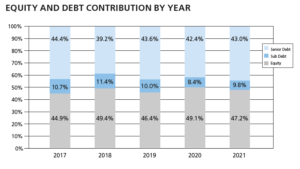By Patrick Stroth
In recent years, Representations and Warranty (R&W) insurance has become available to smaller and smaller deals.
The eligible deal size dropped to under $20M… then under $15M. This is already quite a feat when you consider that the average transaction value (TV) for deals with R&W coverage in place is $500M. And to be honest, most insurers won’t go lower than $100M—Underwriters are already backed up on processing policies and insurance companies don’t always want to take the time to work on smaller deals that won’t generate large amounts of fees.
Now, for the first time ever, this unique type of coverage is available for deals with a TV of $250,000 to $10M. This opens up R&W coverage to a whole new universe of deals.
How did this breakthrough come about? As with many business ideas, someone saw a gap in the market and decided to fill it with what is officially called Transaction Liability Private Enterprise (TLPE) insurance.
According to CFC Underwriting, the London-based insurer that innovated this new insurance product, there were 230,000 deals in which the TV was between $250,000 and $10M. They decided to create a product for this vast unserved market and came up with TLPE insurance as the first to market solution.
Here are the basics on this coverage, which is available worldwide:
- It covers deals with TV from $250,000 to $10M.
- The policies are sell-side only. (In standard R&W insurance there are sell-side and buy-side policies, although the vast majority are buy-side.)
- It offers competitive terms at rates lower than traditional R&W coverage.
- A streamlined underwriting process to ensure both timely execution and sustainability.
- A deal can be insured up to 100% of Enterprise Value (EV).
- Policy period: six years.
Covered industries include professional services, technology service and product businesses, transportation and aviation, and insurance brokers. CFC generally declines deals involving businesses in healthcare, financial services, oil and gas, mining, pharmaceuticals and regulated industries (such as telecommunications).
How It Works
Similar to standard R&W insurance, TLPE covers innocent misrepresentations made by the Seller to the Buyer.
This provides the Sellers peace of mind because they know they won’t have to risk some or all of their proceeds from the deal in the event of a breach. On the other side, Buyers enjoy a feeling of confidence because there is a guaranteed source of funds available to cover their loss.
Unlike the vast majority of R&W policies, TLPE is strictly a sell-side product. The policy is “triggered” only by a claim brought by the Buyer against the Seller for a loss caused by a breach of the Seller’s representations in the Purchase and Sale Agreement.
As part of this coverage, the Seller is entitled to have their legal defense to contest the Buyer’s claim paid for by the insurer. Underwriters have full authority on the selection of the Seller’s defense counsel, which enables them to control claims costs. The insurance company will also cover any damages or settlement amounts.
Something not in a standard Buyer-side R&W policy is the exclusion for Seller fraud.
While no insurance policy will cover known fraudulent acts, TLPE will pay the legal fees to defend the Seller against allegations of fraud. However, they will cease providing defense costs if actual fraud is established in court.
Important: if the Buyer sues the Seller for something not related to a breach, the insurer does not provide legal defense.
Quick and Easy
TLPE offers streamlined and cost-effective underwriting:
- An application is required, but Underwriters depend on the Seller’s knowledge of their own business. Who knows the business better than an owner/founder?
- There are no underwriting fees, which saves policyholders $30,000 to $50,000.
- No underwriting call is required.
- The turnaround time is just three days after transaction documentation is submitted and responses to any underwriting questions are provided.
This quick and easy process is possible because the Underwriters are not viewing the reps. They’re not looking at the due diligence collected. They are simply underwriting the application that the Seller provided.
TLPE in Action
TrenData is a Dallas-based SaaS company that offers various human resources services. A larger human resources technology firm was planning to acquire them. The TV was about $5M.
What held up the deal was the Buyer insisted that in the event of a breach of the intellectual property (IP) rep, that the target company would be responsible for any legal expenses or loss. At the same time, the Buyer would retain the sole authority for selecting their own legal counsel and determining the legal strategy.
As the target company noted, this is like essentially writing a blank check. The Buyer could easily hire high-priced attorneys and/or drag the case on and on. They would not go for it.
Neither side would budge on this issue, and it seemed like the deal was lost.
However, less than a week later, the Seller reached out to my firm, Rubicon Insurance Services. We discussed TLPE coverage and how it could work in this deal. The Seller contacted the Buyer, and once they found out that the Seller would pay for the policy, that legal costs would be covered in the event of a loss, and that the deal could be insured up to the full $5M in TV…the gap between the two sides was bridged and the deal closed within a week.
What to Do If You’re Interested in Coverage
TLPE seems simple enough. However, there are key conditions and limitations with this new product. So it’s essential you have an insurance broker experienced in M&A handle the process of securing this coverage.
Something to keep in mind: TLPE policies can be placed post-closing, so if you were unable to get protection for a previous deal, it can actually be revisited.
If you’re interested in seeing if TLPE coverage could be a fit for an upcoming – or past – deal, you can contact Patrick Stroth, at pstroth@rubiconins.com.

















